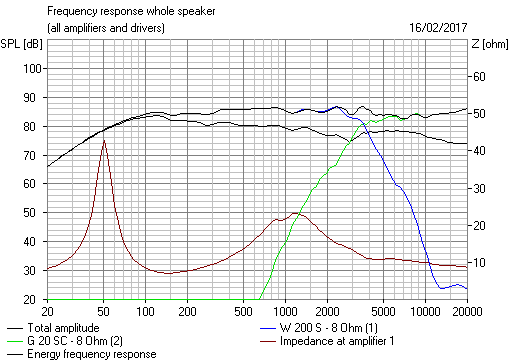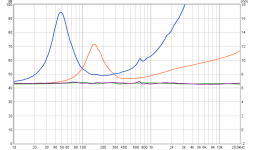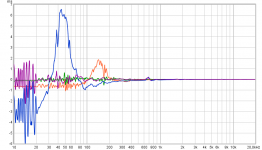or avoid loudspeakers that present a reactive load to the amp...
or as Joe is trying to do, make the relationship better.
That's it. But there are other known mechanisms at work. But some just don't want to know about.
We listen to the current of the amplifier modified by a very unstable back-EMF impedance (an impedance impedes current, not voltage) which at most frequencies are larger in actual Ohm value than the Re of the voice coil.
We listen to modified current all the time when listening to a voltage source.
They very thing that the amp cannot control is the current we end up listening to. The SPL output of the speaker is proportional to that altered current reaching the Re part of the impedance. I set up an 'equivalence' test that proved this conclusively, the SPL was proportional to two things, current and heat dissipation. The result was clear and the basic numbers behind it so simple that they could not be explained away. But I wanted confirmation and I got it.
Several physicists are in agreement with this. It is what is happening, period. The voltage of the amplifier tells us what we should be hearing, but the unchecked current is what we end up listening to. The voltage does not create the force factor that causes the coil and cone to move. The dissipation of heat only occurs across the Re part of the impedance. The back-EMF impedance is actually an anti-voltage that impedes current, and also changes the current phase angle (the sound we hear is kinda delayed, but that is a lesser problem).
Any resonance or imperfection shows up in that back-EMF impedance in series with Re and the things starts to cycle current and chasing its own tail. The Re itself curtails it to a degree. Any added series impedance will also help that is the current driving angle). I am working on possible ways to measure this, but also seeking help to do so. I want collaboration, not fighting.
You can only go so far on social media to explain this, the world is becoming too polarised on just about every subject there is. A sign of the times. But I have written a discussion paper that I am gradually releasing to increasing number of people, and it is getting traction.
So I feel that on this thread I have gone as far as I can. I don't want to become a bone of contention. Have learned how unpleasant that can be.
So from here on, my input will be more sparse. Best to keep the peace.
Cheers, Joe
Last edited:
...The reactive "bad current" is only a smokescreen due to lack of understanding of what is going on.
Could be or perhaps it is even simpler that. What is it that people need so desperately every day? (Rhetorical question)
(an impedance impedes current, not voltage)
You see, why do I bother? I'll leave others to translate and go now.
so in Brytt's last plot the orange is raw, the green is compensated?
Precise although note its cone is a relative less diameter and probably extreme small numbers for effective mass (Mms) compared to higher same numbers of woofer drivers you intend to run in parallel yourself meaning power and brake of parallel network compensation feeding to ground is hotter there. For visual comparison in below attached graphs you see a single 10 inch woofer into sealed enclosure overlaid to that previos post using small diameter widebanders.
Re below maybe those post 15061 graphs say nothing but think its collaboration so miss a comment 🙂
...I want collaboration, not fighting...
Attachments
so the blue line is the 10? (should include a legend of colors)
thanks for confirming my thinking that parallel drivers makes the situation worse.
thanks for confirming my thinking that parallel drivers makes the situation worse.
Yes blue are one 10 inch woofer and orange is 25 times 3 inch widebanders, but i'm not shure agree your thinking where situation is worse its just that if you want to use networks to compensate then situation change needs for value and numbers of components and also in general small leight cones verse big heavy ones (physics) and their intended frq domain coverage means something in the puzzle, suggest try model behavour into free XSim or VituixCAD.
ok thanks Brytt more homework on Xsim (i think there's a little something lost in translation)
the compensation has to be applied to the specific situation? not individual drivers?
the compensation has to be applied to the specific situation? not individual drivers?
Its dynamic and user selectable for case to case for example same compensation network that works for one induvidual driver can work for multible drivers where you have to add same numbers more of multible networks that you also add drivers, but also you can measure or model new situation of multible drivers and make you one nice new compensation network using other and fewer component values that works for that situation. Other dynamics that change situation is for example if its also a multiway situation and if that multi way use passive or active XO points, for multiway passive XO speaker system it also mean alot if compensation network is situated before or after the passive XO network, so alot of dynamics to counter and deside for.
So what amp are you using that is perfect? I ask because I have never experienced an amp that works the same as spec shows under real speaker loads, regardless of price.
It doesn't have to be perfect, it just has to be inaudible. Not being an amplifier expert I won't comment on your last sentence other than to say that it is my understanding that amplifiers can be made to be inaudible and if they are not then they are poor designs. I do tend to agree that the specs normally given for amps are seriously lacking. The same is true for speakers, or all audio products for that matter. Marketing likes it that way. It's easier to spin good performance than actually create it.
You see, why do I bother? I'll leave others to translate and go now.

Hehe, are you going to give up now like Earl said he was but didn't?
I gave up on Joe, but I will still discuss with others as long as they stay civil and listen. Still this discussion should be moved, but I guess that Joe is not inclined to do that.
Last edited:
True.I gave up on Joe, but I will still discuss with others as long as they stay civil and listen. Still this discussion should be moved, but I guess that Joe is not inclined to do that.
He already had this discussion on the Blowtorch thread......nuf sed
That's it. But there are other known mechanisms at work. But some just don't want to know about.
We listen to the current of the amplifier modified by a very unstable back-EMF impedance (an impedance impedes current, not voltage) which at most frequencies are larger in actual Ohm value than the Re of the voice coil.
this must also apply to the invisible intruder in the old film Forbidden Planet. the intruder was created via some type of psychic connection to a virtually unlimited energy plant. the 'energy monster', as it might be termed, must be not of voltage, but rather current?😀
You are correct to point out we are listening to the modified current. But drivers and speakers are designed to produce suitable sound under those conditions.We listen to modified current all the time when listening to a voltage source....
Any resonance or imperfection shows up in that back-EMF impedance in series with Re and the things starts to cycle current and chasing its own tail. The Re itself curtails it to a degree. Any added series impedance will also help that is the current driving angle)....
The back-EMF is not random. It is in exact relation to the cone motion, allowing for erroneous motion, of course. With a constant-current source, the error back-EMF is a small factor which falls within the larger total speaker impedance, except at speaker resonance.
With constant-current, there is an adjustment for the introduction to the error back-EMF and this, I suppose is slightly reflected in the reduction of the error in the sound output. A constant-current amp has a gigantic output impedance, duh.
But with motional feedback, the amp has a negative impedance characteristic* and can be the mirror-image of the speaker's impedance - which makes more sense than just providing constant-current. It corrects the error back-EMF and with greatest impact on our enjoyment, at the "error" of resonance.
B.
* and curiously, that is true even when using a accelerometer for feedback
Last edited:
You see, why do I bother? I'll leave others to translate and go now.
I am quoting a physicist. You disagree with him? I am not.
this must also apply to the invisible intruder in the old film Forbidden Planet. the intruder was created via some type of psychic connection to a virtually unlimited energy plant. the 'energy monster', as it might be termed, must be not of voltage, but rather current?😀
Strange comment and fully detached from any actual context of the subject.
 So no need for me to comment except ask why do you think there is any monster at all?
So no need for me to comment except ask why do you think there is any monster at all?I'm really not learning anything here. Am I the only person who knows about scattering matrices?
https://en.wikipedia.org/wiki/Scattering_parameters
We can do this:

Or this:

Not rocket science. Both work well enough. But the second one is interesting, eh? 😎
https://en.wikipedia.org/wiki/Scattering_parameters
We can do this:
Or this:
Not rocket science. Both work well enough. But the second one is interesting, eh? 😎
Am I the only person who knows about scattering matrices?
Really!? 🙄
- Status
- Not open for further replies.
- Home
- Amplifiers
- Solid State
- Back-EMF and flat impedance


